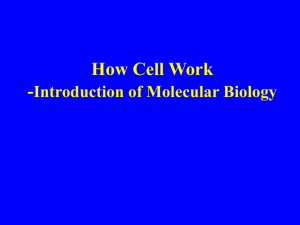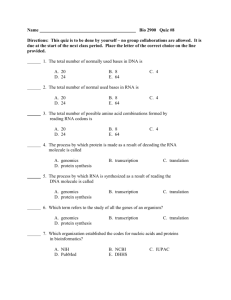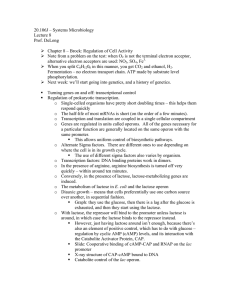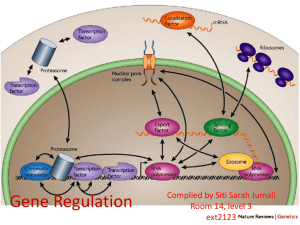Kevin Ahern's Biochemistry Course (BB 350) at Oregon State University
advertisement
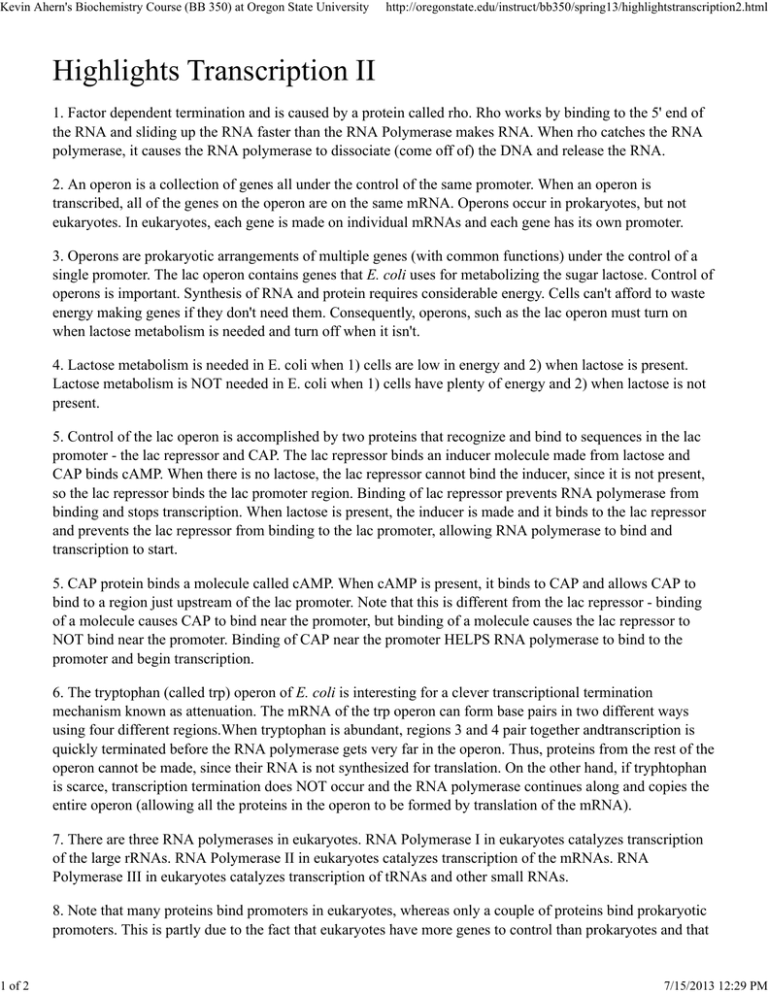
Kevin Ahern's Biochemistry Course (BB 350) at Oregon State University http://oregonstate.edu/instruct/bb350/spring13/highlightstranscription2.html Highlights Transcription II 1. Factor dependent termination and is caused by a protein called rho. Rho works by binding to the 5' end of the RNA and sliding up the RNA faster than the RNA Polymerase makes RNA. When rho catches the RNA polymerase, it causes the RNA polymerase to dissociate (come off of) the DNA and release the RNA. 2. An operon is a collection of genes all under the control of the same promoter. When an operon is transcribed, all of the genes on the operon are on the same mRNA. Operons occur in prokaryotes, but not eukaryotes. In eukaryotes, each gene is made on individual mRNAs and each gene has its own promoter. 3. Operons are prokaryotic arrangements of multiple genes (with common functions) under the control of a single promoter. The lac operon contains genes that E. coli uses for metabolizing the sugar lactose. Control of operons is important. Synthesis of RNA and protein requires considerable energy. Cells can't afford to waste energy making genes if they don't need them. Consequently, operons, such as the lac operon must turn on when lactose metabolism is needed and turn off when it isn't. 4. Lactose metabolism is needed in E. coli when 1) cells are low in energy and 2) when lactose is present. Lactose metabolism is NOT needed in E. coli when 1) cells have plenty of energy and 2) when lactose is not present. 5. Control of the lac operon is accomplished by two proteins that recognize and bind to sequences in the lac promoter - the lac repressor and CAP. The lac repressor binds an inducer molecule made from lactose and CAP binds cAMP. When there is no lactose, the lac repressor cannot bind the inducer, since it is not present, so the lac repressor binds the lac promoter region. Binding of lac repressor prevents RNA polymerase from binding and stops transcription. When lactose is present, the inducer is made and it binds to the lac repressor and prevents the lac repressor from binding to the lac promoter, allowing RNA polymerase to bind and transcription to start. 5. CAP protein binds a molecule called cAMP. When cAMP is present, it binds to CAP and allows CAP to bind to a region just upstream of the lac promoter. Note that this is different from the lac repressor - binding of a molecule causes CAP to bind near the promoter, but binding of a molecule causes the lac repressor to NOT bind near the promoter. Binding of CAP near the promoter HELPS RNA polymerase to bind to the promoter and begin transcription. 6. The tryptophan (called trp) operon of E. coli is interesting for a clever transcriptional termination mechanism known as attenuation. The mRNA of the trp operon can form base pairs in two different ways using four different regions.When tryptophan is abundant, regions 3 and 4 pair together andtranscription is quickly terminated before the RNA polymerase gets very far in the operon. Thus, proteins from the rest of the operon cannot be made, since their RNA is not synthesized for translation. On the other hand, if tryphtophan is scarce, transcription termination does NOT occur and the RNA polymerase continues along and copies the entire operon (allowing all the proteins in the operon to be formed by translation of the mRNA). 7. There are three RNA polymerases in eukaryotes. RNA Polymerase I in eukaryotes catalyzes transcription of the large rRNAs. RNA Polymerase II in eukaryotes catalyzes transcription of the mRNAs. RNA Polymerase III in eukaryotes catalyzes transcription of tRNAs and other small RNAs. 8. Note that many proteins bind promoters in eukaryotes, whereas only a couple of proteins bind prokaryotic promoters. This is partly due to the fact that eukaryotes have more genes to control than prokaryotes and that 1 of 2 7/15/2013 12:29 PM Kevin Ahern's Biochemistry Course (BB 350) at Oregon State University 2 of 2 http://oregonstate.edu/instruct/bb350/spring13/highlightstranscription2.html eukaryotic genes are not organized in operons. 9. In contrast to prokaryotes, eukaryotic genes are not arranged in operons, but instead are in pieces on a single mRNA. 10. Transcription factors are proteins that bind to specific sequences of DNA and affect transcription. 11. Enhancers are eukaryotic proteins (transcription factors) that bind DNA sequence elements located as far away as several thousand base pairs from a gene. They they can help activate transcription of the relevant gene. Enhancers are specific to specific tissues, thus allowing specific genes to be active in some tissues (which have the transcription factors) and not active in others (that lack the appropriate transcription factors). 7/15/2013 12:29 PM
